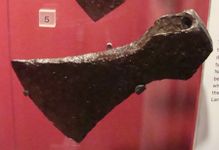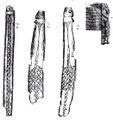Difference between revisions of "Combs"
From The Viking Age Compendium
m |
m |
||
| Line 11: | Line 11: | ||
==Ashby Type 1a - Early Anglo-Saxon== | ==Ashby Type 1a - Early Anglo-Saxon== | ||
| − | Date: AD300-600 | + | Date: AD300-600<br> |
| + | Mainly found in: England, Netherlands, Belgium, Denmark<br> | ||
| + | |||
==Ashby Type 1b - Barred== | ==Ashby Type 1b - Barred== | ||
| − | Date: AD500-800 | + | Date: AD500-800<br> |
| + | Mainly found in: England, Netherlands, Belgium, France<br> | ||
| + | |||
| + | ==Ashby Type 1c - High-backed== | ||
| + | Date: AD450-800<br> | ||
| + | Mainly found in: Scotland, Ireland<br> | ||
| + | |||
| + | ==Type 2a - Flat-sided== | ||
| + | Date: AD600-900<br> | ||
| + | Mainly found in: England, Netherlands, Belgium, France<br> | ||
| + | <br> | ||
| + | The flat connecting plates are cut from the ribs of sheep or other domestic mammals | ||
| + | |||
| + | ==Type 2b - Bowed== | ||
| + | Date: AD600-900<br> | ||
| + | Mainly found in: England, Netherlands, Belgium, France<br> | ||
| + | Frequently referred to as 'hogback' or 'winged' combs. | ||
| + | |||
| + | ==Type 2c - Coped== | ||
| + | Date: AD600-900<br> | ||
| + | Mainly found in: England, Netherlands, Belgium<br> | ||
| + | They are most common in the Netherlands, but also appear in small numbers in the southern British Isles. | ||
| + | |||
| + | {{Seen|Replica by Gavin Archer}} | ||
| + | |||
| + | ===England, York: Coppergate=== | ||
| + | {{Cat| | ||
| + | :Find Type- ? | ||
| + | :Find Date- ? | ||
| + | :Beam- | ||
| + | :Plates- | ||
| + | :Comments- | ||
| + | :Bibliography- | ||
| + | :*{{ListRef|Wheeler 1927|fig.10(1)}} | ||
| + | |Seen= yes | ||
| + | |Museum= Jorvik Viking Museum | ||
| + | |Accession= | ||
| + | |i1=axe_Thames_Street.jpg | ||
| + | |i2=London-Axe Thames Street.JPG | ||
| + | }} | ||
| + | <!-- End of Replica --> | ||
| + | |} | ||
| − | |||
| − | |||
==Type 3 - == | ==Type 3 - == | ||
Revision as of 20:58, 9 September 2023
More Crafts pages
Viking Age Compendium articles on Crafts:
Viking Age Compendium articles on Crafts:
Intro here
Typology
We are using Steven Ashby's Typology.
Ashby Type 1a - Early Anglo-Saxon
Date: AD300-600
Mainly found in: England, Netherlands, Belgium, Denmark
Ashby Type 1b - Barred
Date: AD500-800
Mainly found in: England, Netherlands, Belgium, France
Ashby Type 1c - High-backed
Date: AD450-800
Mainly found in: Scotland, Ireland
Type 2a - Flat-sided
Date: AD600-900
Mainly found in: England, Netherlands, Belgium, France
The flat connecting plates are cut from the ribs of sheep or other domestic mammals
Type 2b - Bowed
Date: AD600-900
Mainly found in: England, Netherlands, Belgium, France
Frequently referred to as 'hogback' or 'winged' combs.
Type 2c - Coped
Date: AD600-900
Mainly found in: England, Netherlands, Belgium
They are most common in the Netherlands, but also appear in small numbers in the southern British Isles.
England, York: Coppergate
|
Type 3 -
Type 4 - Horn
Type 5 - Norse
Type 6 - Short
Type 7 - Long
Type 8i - Short
Type 8ii - Long
Type 8iii -
Type 9 - Copper
References
Arbman, Holger (1940) Birka 1 Die Graber: Tafeln. [The Graves: Plates] Birka, Kungliga Vitterhets Historie och Antikvitets Akademien [ARBMAN 1940] *
Ashby, Steve (2007) 'Bone and Antler Combs' Finds Research Group Datasheets 25-40: No.40 [ASHBY 2007] *
Ashby, Steven P. (2014) A Viking Way Of Life. Combs and Communities in Early Medieval Britain. [ASHBY 2014] *









